

Critical Thinking and Writing at Masters Level - Some Tips! The Role of Emotional Thinking in Critical Thinking — Work Faster. Work Smarter. Overcoming Obstacles to Critical Thinking. The ability to think critically is one skill separating innovators from followers.
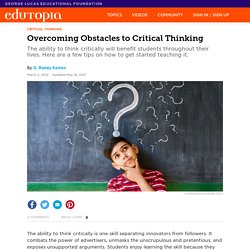
It combats the power of advertisers, unmasks the unscrupulous and pretentious, and exposes unsupported arguments. Critical and Creative Thinking. The imparting of knowledge (content) and the development of thinking skills are accepted today as primary purposes of education. The explicit teaching and embedding of critical and creative thinking throughout the learning areas encourages students to engage in higher order thinking.
How to make good arguments at school (and everywhere else) From as early as Grade 3 teachers start teaching children how to put across their own points of view.
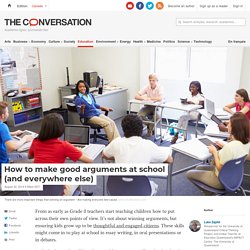
It’s not about winning arguments, but ensuring kids grow up to be thoughtful and engaged citizens. These skills might come in to play at school in essay writing, in oral presentations or in debates. And whether we’re talking about making arguments for school or just in life, there are three things present in all good arguments. Read more: No, you're not entitled to your opinion. All About Asking Better Questions.
Asking questions is such a basic tool of teaching, yet how many of us have ever been taught to ask good questions?

As I started researching for this post, I realized how little I actually knew about asking questions. I asked hundreds of questions a day but had zero training. I know I’m not alone! Here’s the plan: So, we’ll actually start in perhaps a strange place, which is to open with the idea of asking fewer questions as teachers and allowing more room for students to be the questioners. Critical Thinking #3. What Is CT? Revised BT. The Path to CT. Few of us are effective critical thinkers—who has time?

The good news, says Stever Robbins, is that this skill can be learned. by Stever Robbins Can you write a refresher on critical thinking? Teaching CT. HO Grid (Music) A CT Model. To Analyze Thinking We Must Identify and Question its Elemental Structures Standard: Clarityunderstandable, the meaning can be grasped Could you elaborate further?
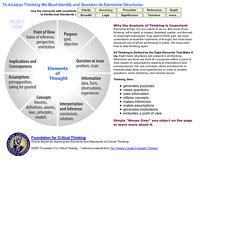
Could you give me an example? Could you illustrate what you mean? Standard: Accuracyfree from errors or distortions, true. 10 Examples of CT. We all encounter opportunities in our daily lives to engage problems and decisions using strong critical thinking.

Everyone needs to think ahead, to plan and to problem solve. What Students Gain From Learning Ethics in School. Critical Friends: A-Z Resources. Reviewed: January 2008 This page has been kept for reference.
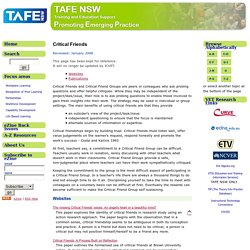
It will no longer be updated by ICVET. Critical Friends and Critical Friend Groups are peers or colleagues who ask probing questions and offer helpful critiques. 5 irrational thinking patterns — and how to start challenging them. iStock If you’d like to see the ways your mind is leading you astray, it’s not enough to look at what you’re thinking.
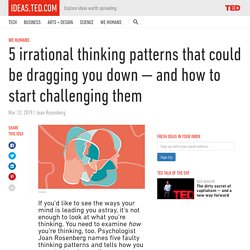
You need to examine how you’re thinking, too. Psychologist Joan Rosenberg names five faulty thinking patterns and tells how you can start to change them. If you looked at the contents of your mind, would most of your thoughts be positive, optimistic and accepting, or negative, pessimistic and cynical? Approaches to Learning Thinking Skills. Critical Thinking Model 1. To Analyze Thinking We Must Identify and Question its Elemental Structures Standard: Clarityunderstandable, the meaning can be grasped Could you elaborate further?

The Trust Project. External Resources Below we’ve collected some highly regarded, useful polls and other research on trust in the news and related trends.
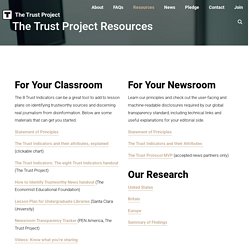
Gallup News Media Viewed as Biased but Crucial to Democracy (2020) Americans Say it’s Important for the News Media to Reflect Diversity (2020) American Views 2020: Trust, Media and Democracy (2020) U.S Media Trust Continues to Recover (2018) EL PENSAMIENTO CRÍTICO EN LAS CLASES DE ESPAÑOL DE IB Y AP – DIEGO OJEDA. Queridos amigos, es con mucha alegría y gusto que comparto con ustedes el webinario que junto con nuestra colega Viviana Orozco, presentamos acerca la importancia del pensamiento crítico en las clases de Español en los programas de IB y AP.
Banning laptops in the classroom helped foster critical thinking. When I announced to second-year undergraduate students that I was banning the use of laptops in one of my units, they reacted just as you might have expected. Even though I carefully outlined my rationale – to foster critical thinking by promoting active class participation – many students remained sceptical. I quickly discovered that the source of this unease had less to do with the devices themselves and more to do with the fears that our education system engenders. Students are academically weighed and measured so frequently that their concept of “learning” entails taking copious notes to ensure that the information delivered can be regurgitated in an assignment or exam. These students are digital natives who can type faster than they write, so laptops are their survival tools – and I had just banned their use for a semester.
I am not a technophobe, and I have nothing against laptops or technology in the classroom. I now enforce a laptop ban on all the modules I teach. EL PENSAMIENTO CRÍTICO EN LAS CLASES DE ESPAÑOL DE IB Y AP – DIEGO OJEDA. Why Do Smart People Do Foolish Things? We all probably know someone who is intelligent but does surprisingly stupid things. My family delights in pointing out times when I (a professor) make really dumb mistakes. What does it mean to be smart or intelligent? Our everyday use of the term is meant to describe someone who is knowledgeable and makes wise decisions, but this definition is at odds with how intelligence is traditionally measured. The most widely known measure of intelligence is the intelligence quotient, more commonly known as the IQ test, which includes visuospatial puzzles, math problems, pattern recognition, vocabulary questions and visual searches. The advantages of being intelligent are undeniable. The ability to think critically, on the other hand, has been associated with wellness and longevity.
Meet the start-up that wants to sell you civilised debate. Why Creating A Culture Of Inquiry Is So Important - Why Creating A Culture Of Inquiry Is So Important by Drew Perkins, Director of TeachThought PD Imagine yourself sitting across from a mortgage broker sometime in the early 2000’s. The economy is riding high and you’ve decided to stake out your portion of the American dream of home ownership but you’re a first-time home buyer. 550 Prompts for Narrative and Personal Writing. [Sign up for our free Learning Network newsletter. Receive new writing prompts in your inbox every week.] We’ve been posting fresh writing prompts every school day for over a decade now, and every so often we create a themed collection like this one to help you find what you need all in one place.
This fall, in honor of our new narrative-writing unit and our first-ever Personal Narrative Essay Contest for teenagers, we’ve rounded up 550 evergreen questions on everything from family, friendships and growing up to gender, spirituality, money, school, sports, social media, travel, dating, food, health and more. Why Content Knowledge is Crucial to Effective Critical Thinking - MindShift. How Finland starts its fight against fake news in primary schools. You can start when children are very young, said Kari Kivinen. In fact, you should: “Fairytales work well. Take the wily fox who always cheats the other animals with his sly words.
That’s not a bad metaphor for a certain kind of politician, is it?” How to think, not what to think. How 'Slow Looking' Can Help Students Develop Skills Across Disciplines. Eight seconds — that’s the latest estimate of the length of the human attention span. The push to cover more material in the same amount of classroom time also provides a challenge, especially when teachers are told that the skills (like critical thinking and creativity) their students will need in order to compete in the 21st century are ones that take time to develop. For educators working with a new generation raised in a world of rapid information exchange, it may seem difficult to hold students’ attention when it comes time for extended observation. As an antidote, Project Zero researcher Shari Tishman offers “slow looking" — the practice of observing detail over time to move beyond a first impression and create a more immersive experience with a text, an idea, a piece of art, or any other kind of object.
It’s a practice that clears a space for students to hold and appreciate the richness of the world we live in. Using MMTS To Engage Students! - mamawolfe. Using MMTS (multimedia text sets) is a simple, but not necessarily easy, strategy to engage students in topics, explore perceptions and get kids excited to learn! Kialo Edu - The tool to teach critical thinking and rational debate.
How to Prepare Social Studies Students to Think Critically in the Modern World. “The consequence of this approach, coupled with a preference by many schools for multiple-choice assessments, turns out students who are disillusioned with social studies—and creates an environment where “accumulating knowledge and memorizing information is emphasized because that’s what counts on standardized tests,” writes Franz. In his book Why Learn History (When It’s Already on Your Phone), author Sam Wineburg, a professor at Stanford’s Graduate School of Education, examines how historians approach resources and argues that this is how teachers should be rigorously vetting—and teaching students to vet—social studies materials for the classroom.
Wineburg first describes how an AP US History student analyzes a New York Times article from 1892 about the creation of Discovery Day, later renamed Columbus Day. The student criticizes the article for celebrating Columbus as a noble hero when, in fact, he “captured and tortured Indians.” Project Zero.
Why crows are much smarter than you think - BBC Ideas. 8 Critical Learning Reflections That Promote Deeper Thinking – Wabisabi Learning. The use of learning reflections in a classroom is a powerful practice for any modern learner. Noam Chomsky on the Dangers of Standardized Testing. “The assessment itself is completely artificial. Playlist: All kinds of minds. (TED is on its annual two-week vacation. During the break, we’re posting playlists from the TEDTalks archive. We’ll be back with new talks on August 29th.) “If you could only see the world the way I see it …” Four TEDTalks from non-neurotypical thinkers, people whose minds work in extraordinary and unusual ways. 1) Temple Grandin, diagnosed with autism as a child, talks about how her mind works — sharing her ability to “think in pictures,” which helps her solve problems that neurotypical brains might miss.
She makes the case that the world needs people on the autism spectrum: visual thinkers, pattern thinkers, verbal thinkers, and all kinds of smart geeky kids. Adam Grant: The surprising habits of original thinkers. Gathering Evidence of Student Achievement - Google Slides. Thinking Skills. Independent Thinking. Thinking Palette : Artful Thinking. The framework takes the image of an artist’s palette as its central metaphor. Critical Thinking. The Big List of Bloom's Taxonomy Question Stems. Thinking Dispositions. Critical Thinking. 12 Solid Strategies for Teaching Critical Thinking Skills.